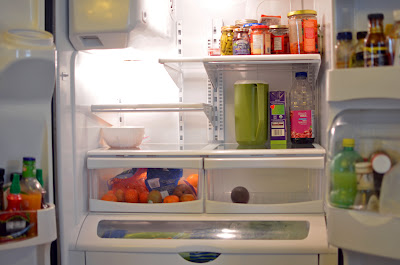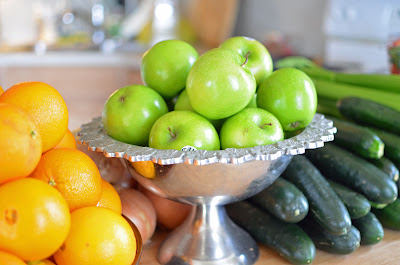Have you ever heard or maybe said this yourself: “I want to eat healthier, but I just can’t afford all those fruits & vegetables!”?
I want to show you how I save $327.63 (just a rough estimate, actually) on my monthly grocery bill, so I do have money for lots of delicious fruits & veggies for myself & my family (& you can too!).
But first, a few random tid-bits.
Did you know that the average American spends 2.5 hours engaged in eating & drinking daily?
68.5 of those minutes are primary eating & drinking activities (meaning the “main” activity).
More fun facts (source: USDA):
- 68% of eating takes place at home
- The average American spends 33 minutes a day doing meal prep/clean up
- 73% of women “usually” do the grocery shopping
People ask me how much money our family spends on food each month.
When I respond somewhere north of $750, the response is often surprise. “That is so much!” I’ve gotten this enough times that I’ve begun to think that perhaps we are a bit extravagant in our shopping habits.
Maybe it’s because I live in Utah where we are not ashamed about our thrifty approach to life, that $700 for a family of 6 seems like a lot for a food budget.
The mindset about purchases here, is often, “What, you didn’t get that 50% off!? You were ripped off.”
Utah has been the home of coupons & deals long before extreme-couponing was invented. We set the standards for frugality, & we’re proud of it. But sometimes our frugality can turn in to shear tight-waddedness, or the expectation that everything needs to be free, or pretty darn close to it (what about honest payment for honest work done/recieved?).
I like a good deal as much as anyone. And I don’t want to have to pay more than I have to, especially since I don’t have a lot of money to throw around.That said, something strikes me as not quite right when people on TLC’s “Extreme Couponing” (have you seen it?) go to whatever means necessary to get their entire cart of groceries for free (made possible by combining coupons with store-sponsored sales).
“Wow! You got $500 worth of groceries for $5!” the cashier says as he hands the receipt to a beaming woman holding a baby. I remember one man “buying” dozens & dozens of boxes of toothpaste just because he could get it all for “free” with his coupons & the store’s sale.
 |
| Our “empty” fridge, just before going shopping on “shopping day” |
Out of curiousity, I checked the USDA’s website to see how much our family “should” be spending on food. Based on the USDA official data tables, my family of 6 would spend the following each month:
[USDA official food plans: see how your food budget compares,
here]
Under a “thrifty” plan: $811/month, or $9,732/yr
Moderate: $1047/month, or $12,564/yr
Liberal: $1291/month, or $15,492/yr
You see how saving a few hundred dollars a month is a difference of several thousand dollars over the course of the year!
Based on these charts, our family doesn’t spend an unreasonable amount on food, in fact, we’d be categorized as “thrifty.” Here’s the thing, I think in actuality we have a liberal food plan, but we only pay for a “thrifty” food plan.
Meaning, I usually get about $1300 worth of groceries, but only spend about $800 (which always includes some foods that I put in
my food storage). I’ll show you how I get the savings in a minute.
$800 might seem high to some, but consider that I buy the highest quality food possible (as my budget and savvy ways allow), including large amounts of fresh produce, some vegan convenience foods, & a lot of organic and specialty items.If you’re looking to only spend a few hundred dollars a month on groceries for a family of 4 or 6 AND eat a healthy, variety of fresh plant foods, I’ve got nothing for you. I know it’s totally possible to only spend $150 a month and feed a family of 6 (I’ve seen “Extreme Couponing” remember?), but I’m interested in lots of fresh, quality, varied plant foods, not boxes of Hamburger Helper or cans of cream of mushroom soup.When I shop at my local health foods store, like Good Earth or Sunflower Farmer’s Market, I can occasionally get coupons from the store for some of the items I buy there but there aren’t a lot of these to make a dent in my budget (I’ve yet to see a coupon for tempeh, but I canbuy it on sale).Most coupons that come in the newspaper, are for stuff I’m not interested in like Kraft mac & cheese and Oscar Meyer hot dogs. Not exactly veg friendly, so using coupons to save on organic & vegan foods isn’t a viable way for me to save a ton of money.
And I buy organic foods when I can, usually at Costco, which carries many organic items. Even at Costco, though these generally cost more (up to twice as much) than conventional.
I also buy a lot of specialty items & foods, like tempeh, non-dairy milk, nutritional yeast as well as more expensive items like agave, stevia, gluten-free baking items (like xantham gum) & gluten-free goodies like gf pretzels & crackers.
I try to get the best price possible on these foods & I’ve compared prices & have a pretty good idea of where the best prices are for a particular item. Still, these foods are sometimes twice as much as standard American diet fare & can add up quickly.
Since I spend more on these items, it’s crucial that I only buy what’s on sale for produce.
The only produce items I don’t buy on sale are a few things I can’t get anywhere else, like bags of frozen fruits & vegetables at Costco (or occasionally Sam’s Club), which are often organic. I also buy a few produce items at Costco (like the big bags of pre-washed spinach that I just can’t get anywhere else for such a great price).
So my secret for getting all the items I need to stock my pantry & freezer while still having money left over for ample amounts of fresh produce?
My real, hard-core, hundreds of dollars of savings each month, is accomplished with price matching.I ad-match at Wal-mart, but I know many stores will price-match from other stores. Price-matching means that you can bring in ads from other stores, & that store will match the sale. This saves a lot of time, energy, & money.
Stay tuned for tomorrow’s post, or
part 2, where I will show you all about how price-matching works for me, & how it helps me to save hundreds of dollars each month.
***
How much do YOU (and your family) spend on groceries a month?





Comments